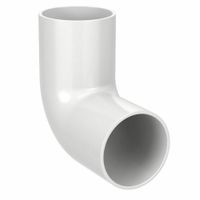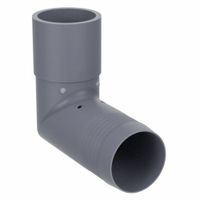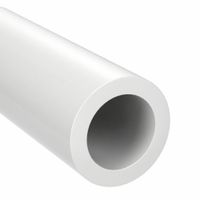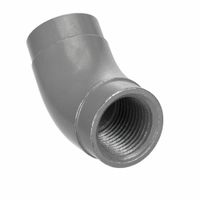Call +(254) 703 030 000 / 751 483 999 / 721 704 777
- Home
- Pipe Hose Tube Fittings
- Pipe Pipe Fittings
- Standard Pipe Pipe Fittings
- Pvc Pipe Systems
.....Read More
Frequently Asked Questions
What are the different types of PVC pipe and fittings available?
PVC pipes and fittings are available in various types, each designed for specific applications:
1. **Schedule 40 PVC**: This is the most common type, used for cold water systems, drainage, and irrigation. It is known for its durability and affordability.
2. **Schedule 80 PVC**: Thicker walls than Schedule 40, making it suitable for higher pressure applications. It is often used in industrial and chemical applications.
3. **CPVC (Chlorinated PVC)**: Withstands higher temperatures than standard PVC, making it ideal for hot water lines and industrial liquid handling.
4. **PVC-U (Unplasticized PVC)**: Rigid and strong, used for potable water, sewage, and drainage systems.
5. **PVC-O (Oriented PVC)**: Enhanced strength and flexibility due to molecular orientation, used in high-pressure water distribution.
6. **PVC-M (Modified PVC)**: Improved toughness and impact resistance, suitable for underground water mains.
**Fittings**:
1. **Elbows**: Used to change the direction of the pipe run, available in 45 and 90 degrees.
2. **Tees**: Allow for branching of the pipe system, available in equal and reducing sizes.
3. **Couplings**: Connect two pipes together, available in slip and threaded versions.
4. **Adapters**: Used to connect pipes of different types or sizes, available in male and female configurations.
5. **Bushings**: Reduce the size of a pipe fitting.
6. **Caps and Plugs**: Seal the end of a pipe, available in slip and threaded versions.
7. **Unions**: Allow for easy disconnection of pipes for maintenance.
8. **Valves**: Control the flow of liquids, available in various types like ball, gate, and check valves.
These types and fittings cater to a wide range of plumbing, industrial, and construction needs.
How do you properly install PVC pipes and fittings?
1. **Plan and Measure**: Determine the pipe layout and measure the required lengths. Mark cutting points.
2. **Cut the Pipe**: Use a PVC pipe cutter or a fine-toothed saw to cut the pipe to the desired length. Ensure cuts are straight and smooth.
3. **Deburr and Clean**: Remove burrs and rough edges with a deburring tool or sandpaper. Clean the pipe ends and fittings with a cloth to remove dust and debris.
4. **Dry Fit**: Assemble the pipes and fittings without adhesive to ensure proper alignment and fit. Mark alignment points with a pencil.
5. **Apply Primer**: Use a PVC primer to clean and soften the pipe and fitting surfaces. Apply it to the outside of the pipe end and the inside of the fitting.
6. **Apply Cement**: Quickly apply PVC cement to the primed areas. Use a brush to spread an even layer on both the pipe and fitting.
7. **Join the Pieces**: Immediately push the pipe into the fitting with a quarter-turn twist to evenly distribute the cement. Hold in place for 30 seconds to ensure a strong bond.
8. **Wipe Excess Cement**: Remove any excess cement with a cloth to prevent weakening the joint.
9. **Cure Time**: Allow the joint to cure as per the cement manufacturer’s instructions, typically 15 minutes for handling and 2 hours for full strength.
10. **Pressure Test**: Once cured, conduct a pressure test to check for leaks. Repair any leaks by reapplying primer and cement.
11. **Support and Secure**: Use pipe hangers or straps to support the pipes, ensuring they are secure and properly aligned.
12. **Final Inspection**: Check the entire installation for alignment, support, and leaks before use.
What are the advantages of using PVC pipes for potable water and sewage systems?
PVC pipes offer several advantages for potable water and sewage systems:
1. **Corrosion Resistance**: PVC pipes are resistant to corrosion from both acidic and alkaline substances, making them ideal for transporting potable water and sewage without degrading over time.
2. **Durability**: They have a long lifespan, often exceeding 50 years, due to their resistance to environmental stress and chemical reactions.
3. **Cost-Effectiveness**: PVC pipes are generally less expensive to produce and install compared to metal pipes, reducing overall project costs.
4. **Lightweight**: Their lightweight nature makes them easier and cheaper to transport and install, reducing labor costs and installation time.
5. **Smooth Interior Surface**: The smooth interior of PVC pipes reduces friction, enhancing water flow efficiency and reducing energy costs for pumping.
6. **Low Maintenance**: Due to their resistance to scale and biofilm formation, PVC pipes require less maintenance, leading to lower long-term operational costs.
7. **Chemical Resistance**: They are resistant to a wide range of chemicals, making them suitable for various applications in sewage systems where chemical exposure is common.
8. **Non-Toxic**: PVC pipes used for potable water are made from food-grade materials, ensuring that they do not leach harmful substances into the water supply.
9. **Versatility**: Available in various sizes and configurations, PVC pipes can be used in diverse applications, from residential plumbing to large-scale municipal sewage systems.
10. **Environmental Impact**: PVC pipes are recyclable, and their production has a lower environmental impact compared to some other materials, contributing to sustainable construction practices.
These advantages make PVC pipes a popular choice for both potable water and sewage systems, balancing performance, cost, and environmental considerations.
How do you ensure PVC pipes are safe for transporting potable water?
To ensure PVC pipes are safe for transporting potable water, follow these steps:
1. **Material Certification**: Use PVC pipes certified by relevant health and safety standards, such as NSF/ANSI 61, which ensures the pipe material is safe for drinking water.
2. **Manufacturing Standards**: Ensure the pipes comply with standards like ASTM D1785 or ASTM D2241, which specify the dimensions, pressure ratings, and quality for potable water applications.
3. **Chemical Resistance**: Verify that the PVC material is resistant to chemicals and does not leach harmful substances into the water. This includes ensuring the absence of lead, phthalates, and other toxic additives.
4. **Installation Practices**: Follow proper installation guidelines to prevent contamination. This includes using appropriate fittings, avoiding cross-connections with non-potable systems, and ensuring clean handling during installation.
5. **Pressure Testing**: Conduct pressure tests to ensure the integrity of the pipe system. This helps identify leaks or weaknesses that could lead to contamination.
6. **Regular Maintenance**: Implement a maintenance schedule to inspect and clean the pipes, ensuring they remain free from biofilm and sediment buildup that could affect water quality.
7. **Temperature Control**: Ensure the pipes are used within their temperature ratings to prevent degradation. PVC pipes are typically rated for temperatures up to 140°F (60°C).
8. **UV Protection**: If exposed to sunlight, use UV-resistant coatings or bury the pipes to prevent degradation from UV exposure, which can affect the pipe's integrity.
9. **Water Quality Testing**: Regularly test the water quality to detect any changes that might indicate contamination from the pipes.
10. **Documentation and Compliance**: Maintain records of certifications, installation procedures, and maintenance activities to ensure compliance with safety regulations and standards.
What are the temperature and pressure limits for PVC pipes?
PVC pipes typically have a maximum service temperature of 140°F (60°C). Beyond this temperature, the material may soften, leading to deformation and potential failure. The pressure rating of PVC pipes is dependent on the pipe's schedule (thickness) and diameter. For example, Schedule 40 PVC pipes can handle pressures up to 450 psi at 73°F (23°C), but this rating decreases as the temperature increases. At 100°F (38°C), the pressure rating drops to about 280 psi. Schedule 80 PVC pipes, which are thicker, can handle higher pressures, up to 630 psi at 73°F (23°C), with a similar reduction in pressure rating at elevated temperatures. It is crucial to consult specific manufacturer data for precise limits, as these can vary based on the pipe's formulation and intended application.
How do you repair or replace damaged PVC pipes and fittings?
To repair or replace damaged PVC pipes and fittings, follow these steps:
1. **Identify the Damage**: Locate the damaged section of the PVC pipe or fitting. Look for cracks, leaks, or breaks.
2. **Turn Off Water Supply**: Shut off the water supply to the affected area to prevent further leakage.
3. **Drain the System**: Open faucets or valves to drain any remaining water from the pipes.
4. **Cut Out the Damaged Section**: Use a PVC pipe cutter or a hacksaw to remove the damaged section of the pipe. Ensure the cuts are straight and clean.
5. **Prepare Replacement Parts**: Measure and cut a new piece of PVC pipe to fit the gap. Ensure it matches the diameter of the existing pipe.
6. **Deburr and Clean**: Use sandpaper or a deburring tool to smooth the edges of the cut pipe. Clean the ends of the existing pipe and the new piece with a PVC cleaner or primer.
7. **Apply PVC Cement**: Apply PVC primer to the outside of the existing pipe ends and the inside of the new fittings. Then, apply PVC cement to the same areas.
8. **Join the Pipes**: Quickly insert the new pipe section into the fittings, ensuring a snug fit. Twist slightly to evenly distribute the cement.
9. **Hold in Place**: Hold the joint together for about 30 seconds to allow the cement to set.
10. **Cure Time**: Allow the joint to cure as per the cement manufacturer's instructions, usually around 15 minutes for handling and 2 hours for full cure.
11. **Test the Repair**: Turn the water supply back on and check for leaks. If no leaks are present, the repair is complete.
12. **Replace Fittings if Necessary**: If fittings are damaged, replace them using the same method as above, ensuring proper alignment and secure connections.
What are the environmental impacts of using PVC pipes?
PVC pipes have several environmental impacts:
1. **Resource Extraction**: PVC (polyvinyl chloride) is derived from petroleum and natural gas, non-renewable resources. The extraction and processing of these resources contribute to habitat destruction, pollution, and greenhouse gas emissions.
2. **Production Emissions**: The manufacturing of PVC involves the release of toxic chemicals, including vinyl chloride, dioxins, and other hazardous air pollutants. These emissions can contribute to air and water pollution, posing health risks to humans and wildlife.
3. **Additives and Stabilizers**: PVC pipes often contain additives like phthalates and heavy metals (e.g., lead, cadmium) to enhance flexibility and durability. These substances can leach into the environment, contaminating soil and water, and potentially entering the food chain.
4. **Non-Biodegradability**: PVC is not biodegradable, leading to long-term environmental persistence. Discarded PVC pipes contribute to plastic pollution, occupying landfill space and potentially releasing harmful chemicals as they degrade.
5. **Recycling Challenges**: PVC recycling is complex due to the presence of additives and the difficulty in separating PVC from other materials. Limited recycling options mean most PVC waste ends up in landfills or incinerators, where it can release toxic emissions.
6. **Incineration Risks**: When incinerated, PVC releases dioxins and other toxic compounds, contributing to air pollution and posing health risks to nearby communities.
7. **End-of-Life Disposal**: Improper disposal of PVC pipes can lead to environmental contamination. Leaching of chemicals from landfilled PVC can pollute groundwater, while burning PVC waste can release harmful emissions.
Overall, while PVC pipes are durable and cost-effective, their environmental impacts raise concerns about sustainability and health, prompting the need for more eco-friendly alternatives and improved waste management practices.



